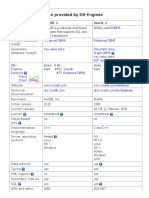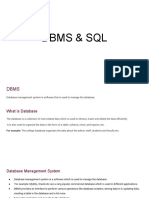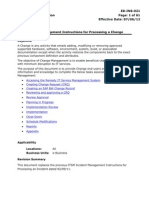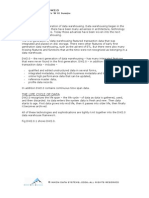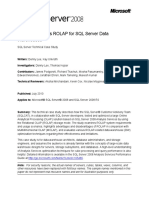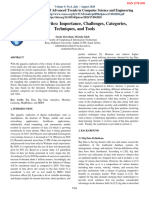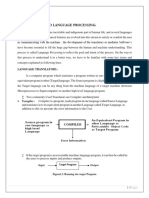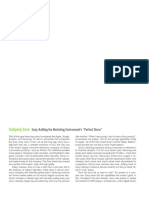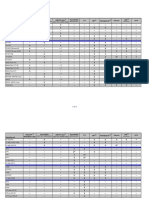0%(1)0% found this document useful (1 vote)
140 viewsNuodb
Nuodb
Uploaded by
snadminPinal Dave is a Technology Enthusiast. He has authored nine SQL Server database books and has written over 2600 articles on the database technology on his blog.
Copyright:
© All Rights Reserved
Available Formats
Download as PDF, TXT or read online from Scribd
Nuodb
Nuodb
Uploaded by
snadmin0%(1)0% found this document useful (1 vote)
140 views60 pagesPinal Dave is a Technology Enthusiast. He has authored nine SQL Server database books and has written over 2600 articles on the database technology on his blog.
Original Title
nuodb
Copyright
© © All Rights Reserved
Available Formats
PDF, TXT or read online from Scribd
Share this document
Did you find this document useful?
Is this content inappropriate?
Pinal Dave is a Technology Enthusiast. He has authored nine SQL Server database books and has written over 2600 articles on the database technology on his blog.
Copyright:
© All Rights Reserved
Available Formats
Download as PDF, TXT or read online from Scribd
Download as pdf or txt
0%(1)0% found this document useful (1 vote)
140 views60 pagesNuodb
Nuodb
Uploaded by
snadminPinal Dave is a Technology Enthusiast. He has authored nine SQL Server database books and has written over 2600 articles on the database technology on his blog.
Copyright:
© All Rights Reserved
Available Formats
Download as PDF, TXT or read online from Scribd
Download as pdf or txt
You are on page 1of 60
NuoDB
re-defined relational database technology
http://bit.ly/nuodb-sql
Pinal Dave
http://blog.sqlauthority.com
Copyright 2013 Pinal Dave
The moral right of the author has been asserted.
All rights reserved.
No part of this publication may be reproduced, stored in a retrieval
system, or transmitted, in any form, or by any means, without the
prior permission in writing of the copyright owner, nor be otherwise
circulated in any form of binding or cover other than that in which it
is published and without a similar condition, including this
condition, being imposed on the subsequent purchaser.
Published 2013
http://blog.sqlauthority.com
NuoDB | iii
Pinal Dave
Pinal Dave is a Technology Enthusiast. He has authored nine
SQL Server database books and has written over 2600 articles on the
database technology on his blog http://blog.sqlauthority.com. Along
with 9+ years of hands on experience, he holds a Masters of Science
degree and a number of certifications, including MCTS, MCDBA and
MCAD (.NET).
http://blog.sqlauthority.com
Authors Foreword
Let us take a look at the amount of information you
process at your own business. If you pay attention to the
underlying database for all these applications, you will be
amazed. These days, every successful business processes way
more data than they used to. The number of transactions and
the amount of data is growing at an exponential rate. Big data
is no longer a concept; it is now a reality.
Let us take a look at the amount of information you
process at your own business. If you pay attention to the
underlying database for all these applications, you will be
amazed. These days, every successful business processes way
more data than they used to. The number of transactions and
the amount of data is growing at an exponential rate. Big data
is no longer a concept; it is now a reality.
You can download NuoDB from here: http://bit.ly/nuodb-sql
vi | PINAL DAVE
NuoDB | vii
Contents
PinalDave.........................................................................................i
AuthorsForeword...........................................................................v
Chapter1.......................................................................................viii
Getting Started with NuoDB ...................................................... 1
Chapter2...........................................................................................7
Quick Start with Admin Sections of NuoDB ............................ 8
Chapter3.........................................................................................15
Quick Start with Explorer Sections of NuoDB ....................... 16
Chapter4........................................................................................25
Voila! Youre Done .................................................................... 31
Download NuoDB ..................................................................... 32
Chapter5.........................................................................................32
SQuirreL SQL Client .................................................................. 33
SQL Workbench/J ...................................................................... 39
DbVisualizer ............................................................................... 42
Summary ..................................................................................... 48
Chapter6.......................................................................................49
One Last Thing ........................................................................... 51
viii | PINAL DAVE
Chapter 1
Getting Started with NuoDB
If you look around there are so many different big data
solutions and it can be a quite difficult task to figure out where to
begin. Personally, I have been experimenting with a lot of different
solutions which allow my database to scale immediately without
much hassle while maintaining optimal database performance. There
are a multitude of solutions out there but for most, even I have to
learn their specific language and there is a lot of new exploration to
do. Honestly, what I prefer is a product that will work with the
language I know (SQL) and follows all the RDBMS concepts which I
am familiar with (ACID etc.).
NuoDB is one such solution. It is an operational NewSQL
database built on a patented emergent architecture with full support
for SQL and ACID guarantees. In this chapter, I will explore how one
can download and install NuoDB database.
Step 1:
Follow these examples to install NuoDB. Go to the NuoDB
download page. Simply fill out the form, accept the online license
agreement, and you will be taken directly to a page where you can
select any platform you prefer to install NuoDB. In my example
below, I selected the Windows 64-bit platform as it is one of the most
popular NuoDB platforms. (You can also run NuoDB on Amazon
Web Services but I prefer to install it on my local machine).
2 | PINAL DAVE
Step 2:
Once you have downloaded the NuoDB installer, double click
on it to install it on the Windows platform.
Here is the enlarged the icon of the installer.
Step 3:
NuoDB | 3
Follow the wizard installation, as it is pretty straight forward
and easy to do.
I have selected all the options to install as the overall
installation is very simple and it does not take up much space.
I have installed it on my C drive but you can select your
preferred drive.
4 | PINAL DAVE
It is quite possible that if you do not have 64 bit Java, it will
throw you the following error. If you face this error, I suggest you
to download 64-bit Java from here.
Make sure that you download 64-bit Java from the following
link: http://java.com/en/download/manual.jsp
NuoDB | 5
If you already have Java 64-bit installed, you can continue with
the installation as shown in the following image. Otherwise, install
Java and start from with Step 1.
As in my case, I already have 64-bit Java installed and you
wont believe me when I say that the entire installation of NuoDB
only took me around 90 seconds, but it is 100% true.
6 | PINAL DAVE
Click on Finish to end to exit the installation.
Step 4:
Once the installation is successful, NuoDB will automatically
open the following two tabs Console and DevCenter in your
preferred browser.
NuoDB | 7
On the Console tab you can explore various components of the
NuoDB solution, e.g. QuickStart, Admin, Explorer, Storefront and
Samples. We will see various components and their usage in future
chapters.
If you follow these steps, which I have shown to install NuoDB,
you will agree that the installation is extremely smooth and it was
indeed a pleasure to install a database product with such ease. If you
have installed other database products in the past, you will
absolutely agree with me.
So download NuoDB and install it today, and in the next
chapter I will take the installation to the next level.
8 | PINAL DAVE
Chapter 2
Quick Start with Admin Sections of NuoDB
In the last chapter we have seen that it is extremely easy to
install the NuoDB database on your local machine. Now that the
application is properly set up, let us explore NuoDB a bit more and
get familiar with the how it works and what the important areas of
NuoDB are that you should learn.
As we have already installed NuoDB, now we will quickly start
with two of the important areas : 1) Admin and 2) Explorer.
In this chapter I will explore how the Admin Section of the
NuoDB Console works. In the next chapter we will learn how the
Explorer Section works.
Let us go to the NuoDB Console by typing the following URL
in your browser: http://localhost:8080/
It will bring you to the following screen:
On this screen you can see a big Start QuickStart button. Click
on the button and it will bring you to following screen. On this screen
you will find very important information about Domain and
Database Settings. I have the habit and maybe you do too to not
read what is written on the screen and keep on clicking on continue
without reading. While we are familiar with most wizards, we can
often miss the very important message on the screen.
NuoDB | 9
Please note the information of Domain Settings and Database
Settings from the following screen before clicking on Create
Database.
Domain Settings
User: quickstart
Password: quickstart
Database Settings
User: dba
Password: goalie
Database: test
Schema: HOCKEY
Once you click on the Create Database button it will
immediately start creating a sample database. First, it will start a
10 | PINAL DAVE
Storage Manager and right after that it will start a Transaction
Engine. Once the engine is up, it will Create a Schema and Sample
Data.
On the completion of creating the sample database it will show
the following screen.
NuoDB | 11
Now is the time to explore NuoDB Admin or NuoDB Explorer.
If you click on Admin, it will first show the following login screen.
Enter for the username domain and for the password bird.
Alternatively you can enter quickstart twice for username and
password. It works as well.
12 | PINAL DAVE
Once you enter into the Admin Section, on the left side you can
see information about NuoDB and the Admin Console and on the
right side you can see the domain overview area.
From this Administrative section you can do any of the
following tasks:
Create a view of the entire domain
Add and remove databases
Start and stop NuoDB Transaction Engines and Storage
Managers
Monitor transaction across all the NuoDB databases
NuoDB | 13
On the right side of the Admin Section we can see various
information about a particular NuoDB domain. You can quickly view
various alerts, find out information about the number of host
machines that are provisioned for the domain, and see the number of
databases and processes that are running in the domain.
If you click on the 1 host link you will be able to see various
processes, CPU usage and other information. In the Processes section
you can see that there are two different types of processes. The first
process (where you can see the floppy drive icon) represents a
running Storage Manager process and the second process a running
Transaction Engine process.
You can click on the links for the Storage
Manager and Transaction Engine to see further statistical details right
down to the last byte of the data.
14 | PINAL DAVE
There are various charts available for analysis as well. I think
the product is quite mature and the user can add different monitor
charts to the Admin section.
NuoDB | 15
Additionally, the Admin section is the place where you can
create and manage new databases. I hope todays tutorial gives you
enough confidence that you can try out NuoDB and checkout various
administrative activities with the database. I am personally
impressed with their dashboard related to various counters.
In the next chapter, we will try out the Explorer section
of NuoDB, which allows us to run SQL queries and write SQL code.
Meanwhile, I strongly suggest you download and install NuoDB and
get yourself familiar with the product.
16 | PINAL DAVE
Chapter 3
Quick Start with Explorer Sections of NuoDB
NuoDB is very innovative and easy-to-use product. I can
clearly see how one can scale-out NuoDB with so much ease and
confidence. In the first chapter we discussed how we can install
NuoDB, and in the second chapter we discussed how we can manage
the NuoDB database transaction engines and storage managers with
a few clicks.
In this chapter, we will learn how we can use the Explorer
feature of NuoDB to do various SQL operations. NuoDB has a
browser-based Explorer, which is very powerful and has many of the
features any IDE would normally have. Let us see how it works in the
following step-by-step tutorial.
Let us go to the NuoDBNuoDB Console by typing the following
URL in your browser: http://localhost:8080/
It will bring you to the QuickStart screen. Make sure that you
have created the sample database. If you have not created sample
database, click on Create Database and create it successfully.
NuoDB | 17
Now go to the NuoDB Explorer by clicking on the main tab,
and it will ask you for your domain username and password. Enter
the username as domain and password as bird. Alternatively you can
also enter username as quickstart and password as quickstart.
18 | PINAL DAVE
Once you enter the password you will be able to see the
databases. In our example we have installed the Sample Database,
hence you will see the Test database in our Database Hierarchy
screen.
When you click on database it will ask for the database login.
Note that Database Login is different from the Domain login and you
NuoDB | 19
will have to enter your database login over here. In our case the
database username is dba and password is goalie.
Once you enter a valid username and password it will display
your database. Further expand your database and you will notice
various objects in your database.
20 | PINAL DAVE
Once you explore various objects, select any database and click
on Open.
NuoDB | 21
When you click on Execute, it will display the SQL script to
select the data from the table. The autogenerated script displays
entire result set from the database.
22 | PINAL DAVE
The NuoDB Explorer is very powerful and makes the life of
developers very easy. If you click on List SQL Statements it will list
all the available SQL statements right away in Query Editor. You can
see the popup window in following image.
Here is the cool thing for geeks. You can even click on Query
Plan and it will display the text based query plan as well. In case of a
SELECT, the query plan will be much simpler, however, when we
write complex queries it will be very interesting. We can use the
query plan tab for performance tuning of the database.
NuoDB | 23
Here is another feature, when we click on List Tables in
NuoDB Explorer. It lists all the available tables in the query editor.
This is very helpful when we are writing a long complex query.
Here is a relatively complex example I have built using Inner
Join syntax. Right below I have displayed the Query Plan. The query
plan displays all the little details related to the query.
24 | PINAL DAVE
Well, we just wrote multi-table query and executed it against
the NuoDB database. You can use the NuoDB Admin section and do
various analyses of the query and its performance.
NuoDB is a distributed database built on a patented emergent
architecture with full support for SQL and ACID guarantees. It
allows you to add Transaction Engine processes to a running system
to improve the performance of your system. You can also add a
second Storage Engine to your running system for redundancy
purposes. Conversely, you can shut down processes when you dont
need the extra database resources.
NuoDB also provides developers and administrators with a
single intuitive interface for centrally monitoring deployments.
If you have read all these chapters and have
not tried out NuoDB, I strongly suggest that you download it today
and catch up on the lessons with me. Trust me, even though the
product is very powerful, it is extremely easy to learn and use.
NuoDB | 25
Chapter 4
Migrate Database from SQL Server to NuoDB
Data is growing exponentially and every organization with
growing data is thinking of the next big innovation in the world of
Big Data. Big Data is a indeed a future for every organization at a
certain point in time. Just like every other next big thing, big data
has its own challenges and issues. The biggest challenge associated
with big data is to find the ideal platform which supports the
scalability and growth of the data. If you are familiar with SQL
Server, you must be familiar with NuoDB. I have been working
with NuoDB for a while and their recent release is the best thus far.
NuoDB is an elastically scalable SQL database that can run
on local host, datacenter and cloud-based resources. A key feature of
the product is that it does not require sharding. In the first chapter,
we were able to install NuoDB in less than 90 seconds and in chapters
2 and 3 we explored the Explorer and Admin sections.
I have shared my love of NuoDB with many friends and
colleagues. One of the frequently asked questions Ive received is if
there is any way to migrate data from SQL Server to NuoDB. The fact
is that there is indeed a way to do so and NuoDB provides a fantastic
tool which can help users to do it. NuoDB Migrator is a command
line utility that supports the migration of Microsoft SQL Server,
MySQL, Oracle, and PostgreSQL schemas and data to NuoDB.
The migration to NuoDB is a three-step process:
NuoDB Migrator generates a schema for a target
NuoDB database
It loads data into the target NuoDB database
It dumps data from the source database
26 | PINAL DAVE
Lets see how we can migrate our data from SQL Server to
NuoDB using a simple three-step approach. But before we do that we
will create a sample database in MSSQL and later we will migrate the
same database to NuoDB:
Setup Step 1: Build a sample data
CREATE DATABASE [Test];
CREATE TABLE [Department](
[DepartmentID] [smallint] NOT NULL,
[Name] VARCHAR(100) NOT NULL,
[GroupName] VARCHAR(100) NOT NULL,
[ModifiedDate] [datetime] NOT NULL,
CONSTRAINT [PK_Department_DepartmentID]
PRIMARY KEY CLUSTERED
( [DepartmentID] ASC )
) ON [PRIMARY];
INSERT INTO Department
SELECT *
FROM
AdventureWorks2012.HumanResources.Department;
Note that I am using the SQL Server AdventureWorks database
to build this sample table but you can build this sample table any
way you prefer.
Setup Step 2: Install Java 64 bit
Before you can begin the migration process to NuoDB, make
sure you have 64-bit Java installed on your computer. This is due to
the fact that the NuoDB Migrator tool is built in Java. You can
download 64-bit Java for Windows, Mac OSX, or Linux from the
following link: http://java.com/en/download/manual.jsp.
NuoDB | 27
One more thing to remember is to make sure that the path in
your environment settings is set to your JAVA_HOME directory
or else the tool will not work. Here is how you can do it:
Go to My Computer >> Right Click >> Select Properties >>
Click on Advanced System Settings >> Click on Environment
Variables >> Click on New and enter the following values.
28 | PINAL DAVE
Variable Name: JAVA_HOME
Variable Value: C:\Program Files\Java\jre7
NuoDB | 29
Make sure you enter your Java installation directory in the
Variable Value field.
Setup Step 3: Install JDBC driver for SQL Server.
There are two JDBC drivers available for SQL Server. Select the
one you prefer to use by following one of the two links below:
Microsoft JDBC Driver
jTDS JDBC Driver
In this example we will be using jTDS JDBC driver. Once you
download the driver, move the driver to your NuoDB installation
folder. In my case, I have moved the JAR file of the driver into the
C:\Program Files\NuoDB\tools\migrator\jar folder as this is my
NuoDB installation directory.
30 | PINAL DAVE
Now we are all set to start the three-step migration process
from SQL Server to NuoDB:
Migration Step 1: NuoDB Schema Generation
Here is the command I use to generate a schema of my SQL
Server Database in NuoDB. First I go to the folder C:\Program
Files\NuoDB\tools\migrator\bin and execute the nuodb-
migrator.bat file.
Note that my database name is test. Additionally my username
and password is also test. You can see that my SQL Server database is
running on my localhost on port 1433. Additionally, the schema of
the table is dbo.
nuodb-migrator schema
source.driver=net.sourceforge.jtds.jdbc.Driver
source.url=jdbc:jtds:sqlserver://localhost:1433/
source.username=test source.password=test source.catalog=test
source.schema=dbo output.path=/tmp/schema.sql
The above script will generate a schema of all my SQL Server
tables and will put it in the folder C:\tmp\schema.sql. You can open
the schema.sql file and execute this file directly in your NuoDB
instance.
Please note that if you have not yet created the schema in the
NuoDB database, you should create it before executing this step.
Migration Step 2: Generate the Dump File of the Data
Once you have recreated your schema in NuoDB from SQL
Server, the next step is very easy. Here we create a CSV format dump
NuoDB | 31
file, which will contain all the data from all the tables from the SQL
Server database.
The command to do so is very similar to the above command.
Be aware that this step may take a bit of time based on your database
size.
nuodb-migrator dump
source.driver=net.sourceforge.jtds.jdbc.Driver
source.url=jdbc:jtds:sqlserver://localhost:1433/
source.username=test source.password=test source.catalog=test
source.schema=dbo output.type=csv output.path=/tmp/dump.cat
Once the above command is successfully executed you can find
your CSV file in the C:\tmp\ folder. However, you do not have to do
anything manually. The third and final step will take care of
completing the migration process.
Migration Step 3: Load the Data into NuoDB
After building schema and taking a dump of the data, the very
next step is essential and crucial. It will take the CSV file and load it
into the NuoDB database.
nuodb-migrator load
target.url=jdbc:com.nuodb://localhost:48004/mytest
target.schema=dbo target.username=test target.password=test
input.path=/tmp/dump.cat
Please note that in the above script we are now targeting the
NuoDB database, which we have already created with the name
of MyTest. If the database does not exist, create it manually before
executing the above script. I have kept the username and password
as test, but please make sure that you create a more secure password
for your database for security reasons.
Voila! Youre Done
32 | PINAL DAVE
Thats it. You are done. It took three setup steps and three
migration steps to migrate your SQL Server database to NuoDB. You
can now start exploring the database and build excellent, scale-out
applications.
In this chapter, I have done my best to come up with a simple
and easy process, which you can follow to migrate your app from
SQL Server to NuoDB.
Download NuoDB
I strongly encourage you to download NuoDB and go through
my 3-step migration tutorial from SQL Server to NuoDB.
NuoDB | 33
Chapter 5
NuoDB and Third Party Explorer
I have introduced each of these chapters with some history of
big data, and why our changing world needs a new way to store
data. Here is one more analogy: Data is indeed a big world and the
learning of Big Data is like spaghetti no one really knows where to
start, you just have to start in the middle. So I decided to learn it with
the help of NuoDB. You can download NuoDB and continue your
journey with me as well.
One question I hear a lot: I like the NuoDB Explorer but can I
connect to NuoDB from my preferred Graphical User Interface?
Honestly, I did not expect this question to be asked of me so many
times, but it is clear that we developers absolutely want to learn new
things and along with that we do want to continue to use our most
efficient developer tools. Now here is the answer to the question:
Absolutely, you can continue to use any of the following most
popular SQL clients. NuoDB supports the three most popular third-
party SQL clients. In all the leading development environments there
are always more than one database installed and managing each of
them with a different tool is often a very difficult task. Developers
like to use one tool, which can control most of the databases. Once
developers are familiar with one database tool it is very difficult for
them to switch to another tool. This is particularly difficult when we
developers find that tool to be the key reason for our efficiency.
Let us see how to install each of the NuoDB supported
third party tools along with a quick tutorial on how to go about using
them.
SQuirreL SQL Client
34 | PINAL DAVE
First download SQuirreL Universal SQL client. On the
Windows platform you can double-click on the file and it will install
the SQuirrel client. Once it is installed, open the application and it
will bring up the following screen. Now go to the Drivers tab on the
left side and scroll it down. You will find NuoDB mentioned there.
Now right click over it and click on Modify Driver.
Now here is where you need to make sure that you make
proper entries or your client will not work with the database. Enter
NuoDB | 35
following values:
Name: NuoDB
Example URL: jdbc:com:nuodb://localhost:48004/test
Website URL: http://www.nuodb.com
Now click on the Extra Class Path tab and add the location of
the nuodbjdbc.jar file. If you are following along with the chapters
and have installed NuoDB in the default location, you will find the
default path as C:\Program Files\NuoDB\jar\nuodbjdbc.jar.
The class name of the driver is automatically populated.
36 | PINAL DAVE
Once you click OK you will see that there is a small icon
displayed to the left of NuoDB, which shows that you have
successfully configured and installed the NuoDB driver.
NuoDB | 37
Now click on the tab of Alias tab and you will notice that it is
empty. Now click on the big Plus icon and it will open screen of
adding an alias.
Alias means nothing more than adding a database to your
system. The database name of the original installation can be
anything and, if you wish, you can register the database with any
other alternative name.
Here are the details you should fill into the Alias screen below.
Name: Test (or your preferred alias)
Driver: NuoDB
URL: jdbc:com:nuodb://localhost:48004/test (This is
for test database)
User Name: dba (This is the username which I entered
for test Database)
Password: goalie (This is the password which I entered
for test Database)
38 | PINAL DAVE
Check Auto Logon and Connect at Startup and click on OK.
Thats it! You are done. On the right side you will see a table
name and on the left side you will see various tabs with all the
relevant details from respective table. You can see various metadata,
schemas, data types and other information in the table.
NuoDB | 39
In addition, you can also generate script and do various
important tasks related to database.
You can see how easy it is to configure NuoDB with the
SQuirreL Client and get going with it immediately.
SQL Workbench/J
This is another wonderful client tool, which works very well
with NuoDB. The best part is that in the Driver dropdown you will
see NuoDB being mentioned there. Click here todownload SQL
Workbench/J Universal SQL client.
The download process is straight-forward and the installation is
a very easy process for SQL Workbench/J. As soon as you open the
client, you will notice on following screen the NuoDB driver when
selecting a New Connection Profile.
Select NuoDB from the drop down and click on OK.
40 | PINAL DAVE
In the driver information, enter following details:
Driver: NuoDB (com.nuodb.jdbc.Driver)
URL: jdbc:com.nuodb://localhost/test
Username: dba
Password: goalie
While clicking on OK, it will bring up the following pop-up.
Click Yes to edit the driver information.
NuoDB | 41
Click on OK and it will bring you to following screen. This is
the screen where you can perform various tasks.
You can write any SQL query you want and it will instantly
show you the results. Now click on the database icon, which you see
right on the left side of the word User=dba.
42 | PINAL DAVE
Once you click on Database Explorer, you can perform various
database related tasks.
As a developer, one of my favorite tasks is to look at the source
of the table as it gives me a proper view of the structure of the
database. I find SQL Workbench/J very efficient in doing the same.
DbVisualizer
DBVisualizer is another great tool, which helps you to connect
to NuoDB and retrieve database information in your desired format.
A developer who is familiar with DBVisualizer will find this client to
be very easy to work with.
The installation of the DBVisualizer is very pretty straight
forward. When we open the client, it will bring us to the following
screen.
As a first step we need to set up the driver. Go to Tools >>
Driver Manager.
NuoDB | 43
It will bring up following screen where we set up the diver. Click on
Create Driver and it will open up the driver settings on the right side.
On the right side of the area where it displays Driver Settings
please enter the following values-
Name: NuoDB
44 | PINAL DAVE
URL Format: jdbc:com.nuodb://localhost:48004/test
Now under the driver path, click on the folder icon and it will
ask for the location of the jar file. Provide the path as a C:\Program
Files\NuoDB\jar\nuodbjdbc.jar and click OK. You will notice there
is a green button displayed at the bottom right corner. This means the
driver is configured properly.
Once driver is configured properly, we can go to Create
Database Connection and create a database.
NuoDB | 45
If the pop up show up for the Wizard. Click on No Wizard and
continue to enter the settings manually.
Here is the Database Connection screen. This screen can
be bit tricky. Here are the settings you need to remember to enter.
Name: NuoDB
Database Type: Generic
Driver: NuoDB
Database URL: jdbc:com.nuodb://localhost:48004/test
Database Userid: dba
Database Password: goalie
46 | PINAL DAVE
Once you enter the values, click on Connect.
Once Connect is pressed, it will change the button value to
Reconnect if the connection is successfully established and it will
show the connection details on the left side.
When we further explore the NuoDB, we can see various tables
created in our test application. We can further click on the right
NuoDB | 47
side screen and see various details on the table.
If you click on the Data tab, it will display the entire data of the
table.
48 | PINAL DAVE
The Tools menu also has some very interesting and cool
features like Driver Manager, Data Monitor and SQL History.
Summary
Well, this was a relatively long chapter but I find it is extremely
essential to cover all the three important clients, which we developers
use in our daily database development. Here is my question to you:
Which one of the following is your favorite NuoDB 3rd-Party
Database Client? (Pick One)
SQuirreL SQL Client
SQL Workbench/J
DbVisualizer
NuoDB | 49
Chapter 6
Final Words
Weve investigated some of the amazing features NuoDB offers,
and if you currently have a database that is getting a little too big to
deal with, you might be completely sold on NuoDB. However, if you
still have a smaller database and arent worried about storage issues
yet, should you bother with NuoDB?
You can probably guess that my answer is going to be yes, and
here is why: NuoDB is totally scalable. If youre starting out small,
start out with NuoDB and skip the transfer later!
NuoDB has zero downtime. That means there is never a power
outage, overload, or server malfunction that will interrupt your
computing, ever again. Big or small, that is a guarantee everyone
could use!
We are operating in an ever-increasing global market. Your
clients and customers might span the globe and time zones. NuoDB
has geo-distribution, which means its available everywhere,
anytime. There is no need to talk someone through setting up their
own server just send them a link for NuoDB.
NuoDB is a great company. They have produced a great
product, and they seem to be really growing. They also support one
of my great interests learning. The NuoDB website hosts webinars
and online courses about their product and about SQL Server,
databases, and more.
There are so many things to love about NuoDB. Weve only
covered the highlights here, but the next time youre thinking about
server upgrades or what you have to do next, think about NuoDB.
NuoDB | 51
One Last Thing
Five more reasons to love NuoDB:
1. NuoDB works great, every time
2. NuoDB operates in the Cloud, keeping it modern and
at the front of the market
3. It is backed by solid venture capitalists good solid
companies
4. NuoDB has won multiple industry awards for
innovation and excellence
5. Databases are only getting larger and more common
NuoDB and its market are not going away anytime
soon!
http://bit.ly/nuodb-sql
Join the Experience
http://blog.sqlauthority.com
http://bit.ly/nuodb-sql
You might also like
- 200 + SQL - Server - Interview - Questions - by Shivprasad KoiralaDocument311 pages200 + SQL - Server - Interview - Questions - by Shivprasad Koiralavaraprasad11987% (39)
- Internship Training ReportDocument36 pagesInternship Training ReportAditya SinghNo ratings yet
- PANDA Mobile Received Module New VersionDocument14 pagesPANDA Mobile Received Module New Versionsnadmin50% (2)
- IT202 Milestone 1 UpdatedDocument6 pagesIT202 Milestone 1 UpdatedBrandon DyceNo ratings yet
- CouchDB Database For The WebDocument73 pagesCouchDB Database For The Webleejiacheng13636No ratings yet
- NuoDB DocumentationDocument142 pagesNuoDB DocumentationDimitri Van Esch0% (1)
- Forrester Wave In-Memory Data GridsDocument16 pagesForrester Wave In-Memory Data GridslumbrigackNo ratings yet
- AdministrationGuide Ioa514agDocument1,018 pagesAdministrationGuide Ioa514agLuis140108No ratings yet
- Istore Case Study: R12 Training ExercisesDocument71 pagesIstore Case Study: R12 Training ExercisesMahesh JayaramanNo ratings yet
- Getting Started With Amazon DocumentdbDocument28 pagesGetting Started With Amazon DocumentdbSpit Fire100% (1)
- Best Practices in Cognos Report StudioDocument4 pagesBest Practices in Cognos Report Studiodhanz_99No ratings yet
- Client Server Architecture A Complete Guide - 2020 EditionFrom EverandClient Server Architecture A Complete Guide - 2020 EditionNo ratings yet
- Interface of Pandapos CounterDocument63 pagesInterface of Pandapos CountersnadminNo ratings yet
- Mongodb Cookbook: Chapter No.1 "Installing and Starting The Mongodb Server"Document40 pagesMongodb Cookbook: Chapter No.1 "Installing and Starting The Mongodb Server"Packt Publishing100% (1)
- NuoDB vs. Oracle ComparisonDocument6 pagesNuoDB vs. Oracle ComparisonsilphansiNo ratings yet
- 03.DynamoDB Data ModelDocument804 pages03.DynamoDB Data ModelhectorNo ratings yet
- Big Data Beyond The HypeDocument393 pagesBig Data Beyond The Hypey.b.ari.handoko.s3949No ratings yet
- DBMS & SQLDocument34 pagesDBMS & SQLSharad DhumalNo ratings yet
- CRQ Creation 4 New RemedyDocument62 pagesCRQ Creation 4 New RemedynareshmadhavaNo ratings yet
- SAS Access 92Document984 pagesSAS Access 92Igor ProtasNo ratings yet
- Azure Stack White Paper v3Document13 pagesAzure Stack White Paper v3SergeyNo ratings yet
- Highcharts Essentials: Chapter No. 1 "Getting Started With Highcharts"Document13 pagesHighcharts Essentials: Chapter No. 1 "Getting Started With Highcharts"Packt PublishingNo ratings yet
- E Advertisement FinalDocument107 pagesE Advertisement FinalSanjana Manisha KongariNo ratings yet
- Talend ESB Container AG 50b enDocument63 pagesTalend ESB Container AG 50b enslimanihaythemNo ratings yet
- Studystatus ReportDocument170 pagesStudystatus ReportRNT 100No ratings yet
- Whitepaper Streaming Data Solutions On Aws With Amazon KinesisDocument33 pagesWhitepaper Streaming Data Solutions On Aws With Amazon KinesisPradipNo ratings yet
- Information Systems Retailers - EditedDocument14 pagesInformation Systems Retailers - Editedaakanksha_rinniNo ratings yet
- Software ArchitectureDocument205 pagesSoftware ArchitectureharishNo ratings yet
- OLAP AssignmentDocument2 pagesOLAP Assignmentobee1234No ratings yet
- MySQL To DB2 RedbookDocument474 pagesMySQL To DB2 RedbookWsharkNo ratings yet
- IBM InfoSphere QualityStageDocument6 pagesIBM InfoSphere QualityStagechand1255No ratings yet
- Datastage Overview: Processing Stage TypesDocument32 pagesDatastage Overview: Processing Stage Typesabreddy2003No ratings yet
- Lab 4 - Installation of Hadoop and MapReduce WordCount ExampleDocument16 pagesLab 4 - Installation of Hadoop and MapReduce WordCount Exampleb.benchenni27100% (1)
- SAS IntroductionDocument13 pagesSAS IntroductionRICHA KUNDANNo ratings yet
- SyscoDocument6 pagesSyscoRohit Meena100% (1)
- Ignite SampleDocument88 pagesIgnite Samplexbsd0% (1)
- QlikView Essentials - Sample ChapterDocument21 pagesQlikView Essentials - Sample ChapterPackt PublishingNo ratings yet
- SAS To WPS Migration Guide For ZOS enDocument28 pagesSAS To WPS Migration Guide For ZOS enaksmsaidNo ratings yet
- IBM Datastage InfoDocument1 pageIBM Datastage Infohemu70No ratings yet
- VIT University: Big Data AnalyticsDocument4 pagesVIT University: Big Data AnalyticsvrkatevarapuNo ratings yet
- MonitoringDocument43 pagesMonitoringసుదర్శన్ మోరాNo ratings yet
- Fab N Sew Garmenents Automation: Software Development ProjectDocument10 pagesFab N Sew Garmenents Automation: Software Development ProjectRatheesh Thana TNo ratings yet
- What Is DW2.0Document13 pagesWhat Is DW2.0Suresh YaramNo ratings yet
- Artificial Intelligence Full Guide PDFDocument661 pagesArtificial Intelligence Full Guide PDFNalin GoswamiNo ratings yet
- IDC Enterprise Applications and Strategies - 2024 SepDocument1 pageIDC Enterprise Applications and Strategies - 2024 SepPriyadi SNo ratings yet
- Object Oriented Programming Lab-03 (GetterSetter, Constructors, MemberFunctions)Document4 pagesObject Oriented Programming Lab-03 (GetterSetter, Constructors, MemberFunctions)Ahmad AbduhuNo ratings yet
- Microsoft - Practicetest.dp 201.v2020!08!07.by - Julissa.92qDocument126 pagesMicrosoft - Practicetest.dp 201.v2020!08!07.by - Julissa.92qrottyNo ratings yet
- Online Medical Shop ManagementDocument66 pagesOnline Medical Shop Managementpoo12820% (1)
- RDSD AssignmentDocument27 pagesRDSD AssignmentMohamed A. Abdelmoneim100% (1)
- EXAM COG-622: IBM Cognos 10 BI AdministratorDocument16 pagesEXAM COG-622: IBM Cognos 10 BI AdministratorSaptarshi Dey0% (1)
- Ssas Rolap For SQL ServerDocument42 pagesSsas Rolap For SQL ServerCuervito NuNo ratings yet
- ParallelJobs PDFDocument84 pagesParallelJobs PDFSaikrishna GollapothuNo ratings yet
- C++ in Hindi: Kuldeep ChandDocument51 pagesC++ in Hindi: Kuldeep Chandanon_742305153No ratings yet
- SybaseDocument692 pagesSybaseNarender GudaNo ratings yet
- Ch1 - A Perspective On TestingDocument41 pagesCh1 - A Perspective On TestingcnshariffNo ratings yet
- or Read: Data Warehouse Textbook PDF EbookDocument8 pagesor Read: Data Warehouse Textbook PDF Ebookbhavinsg100% (1)
- Creating Oracle BI Publisher Report Using Template Builder: ExploreDocument8 pagesCreating Oracle BI Publisher Report Using Template Builder: ExploreAbebeNo ratings yet
- Looking For Real Exam Questions For IT Certification Exams!Document5 pagesLooking For Real Exam Questions For IT Certification Exams!thanhtam3819No ratings yet
- Sample Questions Big Data PreparationDocument4 pagesSample Questions Big Data Preparationkshen2001No ratings yet
- Course Material TableauDocument54 pagesCourse Material Tableausairamakanth14No ratings yet
- Data Pipeline Essentials: See Ya LaterDocument6 pagesData Pipeline Essentials: See Ya LaterDevNo ratings yet
- Microsoft SQL Server Management Studio A Complete Guide - 2021 EditionFrom EverandMicrosoft SQL Server Management Studio A Complete Guide - 2021 EditionNo ratings yet
- Work Instruction Bill of Material 2013Document5 pagesWork Instruction Bill of Material 2013snadminNo ratings yet
- Po and Goods Received Policy (Pay by Invoice Format)Document3 pagesPo and Goods Received Policy (Pay by Invoice Format)snadminNo ratings yet
- Branch Price ChangeDocument4 pagesBranch Price Changesnadmin100% (1)
- Panda Manual Guide - Setup Payment Term 2014Document2 pagesPanda Manual Guide - Setup Payment Term 2014snadminNo ratings yet
- Good Return Debit NoteDocument3 pagesGood Return Debit NotesnadminNo ratings yet
- Penguin - Test Your Vocabulary 5 PDFDocument58 pagesPenguin - Test Your Vocabulary 5 PDFGabriela DiazNo ratings yet
- Penguin - Test Your Vocabulary 2Document64 pagesPenguin - Test Your Vocabulary 2Magazinul de Pantofi100% (1)
- Active Directory Domain Services - All - Dsadd - Parameters PDFDocument3 pagesActive Directory Domain Services - All - Dsadd - Parameters PDFsnadminNo ratings yet
- Penguin Test Your Vocabulary 3 PDFDocument65 pagesPenguin Test Your Vocabulary 3 PDFLauren HeadNo ratings yet
- CS50 Cheat Sheet - NotesDocument9 pagesCS50 Cheat Sheet - NotessnadminNo ratings yet
- VIM Editor Commands: (Ex. 10G Goes To Line 10)Document4 pagesVIM Editor Commands: (Ex. 10G Goes To Line 10)snadminNo ratings yet
- CS50 Appliance 2014Document12 pagesCS50 Appliance 2014snadminNo ratings yet
- Binary Two's ComplementDocument3 pagesBinary Two's ComplementsnadminNo ratings yet
- Windows 7 Reference Guide PDFDocument39 pagesWindows 7 Reference Guide PDFsnadminNo ratings yet
- Berrezueta 2023 Cseet 2Document10 pagesBerrezueta 2023 Cseet 2hezelgaloNo ratings yet
- Exp06 EEE318Document11 pagesExp06 EEE318draw my storybanglaNo ratings yet
- RC Dan FLIP FLOP IC 555Document24 pagesRC Dan FLIP FLOP IC 555assaNo ratings yet
- The Machines Are Learning, and So Are The StudentsDocument6 pagesThe Machines Are Learning, and So Are The StudentsTACN-1TC-19ACN Luong Khanh LinhNo ratings yet
- Game WickipediaDocument6 pagesGame WickipediaAlex BoraNo ratings yet
- Big Data Analytics Importance, Challenges, Categories, Techniques, and Tools (Article) Author Sarah Alswedani, Mostafa SalehDocument9 pagesBig Data Analytics Importance, Challenges, Categories, Techniques, and Tools (Article) Author Sarah Alswedani, Mostafa SalehVar arpNo ratings yet
- Ortho Notes Clinical Examination Pocket Guide all chapter instant downloadDocument15 pagesOrtho Notes Clinical Examination Pocket Guide all chapter instant downloadcallzsumrakNo ratings yet
- A Pre-Authentication Approach To Proxy Re-Encryption in Big Data ContextDocument11 pagesA Pre-Authentication Approach To Proxy Re-Encryption in Big Data ContextAbhishek DasNo ratings yet
- DG SPEC TC313D6-E With 6LTAA8.9G3Document4 pagesDG SPEC TC313D6-E With 6LTAA8.9G3marco corderoNo ratings yet
- Wa0005.Document8 pagesWa0005.nehasatkur99No ratings yet
- 03-032-20061-00 Spyder3 GigE Vision User Manual ColorDocument87 pages03-032-20061-00 Spyder3 GigE Vision User Manual Colort981252991No ratings yet
- Problems: SolutionDocument2 pagesProblems: Solutionsushmita ratagalNo ratings yet
- DSD Course OutlineDocument3 pagesDSD Course Outlinepurushotham.kNo ratings yet
- How To Create Oracle Database Manually On LinuxDocument3 pagesHow To Create Oracle Database Manually On LinuxRedha BoumazaNo ratings yet
- 8th Sem Internship-Project Report GuidelinesDocument17 pages8th Sem Internship-Project Report GuidelinesnasagamerNo ratings yet
- Resume Anvesh Garg RecentDocument2 pagesResume Anvesh Garg RecentVaibhav Moreshwar KulkarniNo ratings yet
- College Management SystemDocument10 pagesCollege Management SystemgomathiNo ratings yet
- Round RobinDocument4 pagesRound RobinKohir ManideepNo ratings yet
- Marketing Environment - SONY Case StudyDocument3 pagesMarketing Environment - SONY Case StudyTrần Quốc Tuấn100% (1)
- Cs101 Midterm Solved Mcqs by JunaidDocument71 pagesCs101 Midterm Solved Mcqs by Junaidsidrahmumtaz1No ratings yet
- CC09 02Document29 pagesCC09 02phamyenvy2012005No ratings yet
- Passive Performance and Building Form - An Optimization Framework For Early-Stage Design SupportDocument19 pagesPassive Performance and Building Form - An Optimization Framework For Early-Stage Design SupportAlptekin TorunNo ratings yet
- Saqib Abass Chalak - CVDocument2 pagesSaqib Abass Chalak - CVAbrar RasoolNo ratings yet
- CBSE Class 11 English Notes PDF for 2025 ExamsDocument6 pagesCBSE Class 11 English Notes PDF for 2025 Examschoudharyanubhav311No ratings yet
- ALS6A603-06 Water Proof PanelDocument2 pagesALS6A603-06 Water Proof PanelDiego CorderoNo ratings yet
- Kable Do Paneli SIEMENSDocument3 pagesKable Do Paneli SIEMENSrafapppNo ratings yet
- C ProgrmmingDocument18 pagesC Progrmmingarvinnagerarvindnager7023No ratings yet
- Network Flows 1.3 Network Representations 1.3 Network RepresentationsDocument35 pagesNetwork Flows 1.3 Network Representations 1.3 Network Representationsnada abdelrahmanNo ratings yet
- Designing of Look Ahead Carry Adder by Using VHDLDocument6 pagesDesigning of Look Ahead Carry Adder by Using VHDLakemaladinNo ratings yet
- MarioGaytanPintore Saltillo DHL PDFDocument3 pagesMarioGaytanPintore Saltillo DHL PDFLuis Jesus Ramos RamirezNo ratings yet















